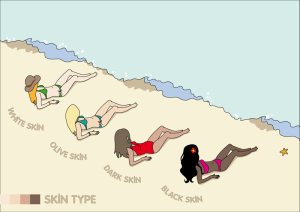Causes of skin cancer are discussed here: Why is skin cancer developing in some people, but not in others? This is a question, which has been asked by cancer researchers for several decades. We do not have all the answers, but we know enough to warrant a more detailed summary about this question.
The most important factors for developing skin cancer is the amount of exposure to ultraviolet light combined with the type of skin the person has. There are 6 skin types that are known (modified according to Ref. 5):
Types of skin that a person can have
|
This difference in skin types explains why skin cancer is frequent in albino people who have a genetic absence of pigment cells in the skin, when they move to sun exposed areas in Africa, and why skin cancer is relatively rare in black people.
Depending on what type of skin you have (see table above), you may have to use high SPF sunscreen more often before you go out into the sun. Skin type I, II and III should use sun tan lotion (SPF 30 or more) often on the sun exposed body parts before sun exposure. The following facts point to the UV light being the offender for skin cancer development:
- people with outdoor occupations (sailors, farmers) have more skin cancer than those with inside occupations
- outside workers have a higher incident of skin cancer at the sites of maximal sun exposure (head, neck, back of hands)
- incident of skin cancer correlates directly with proximity to the equator
- chronic UV exposure is now more due to recreational factors rather than occupational factors and depletion of ozone layer from air pollution is the likely cause for the observed increase in skin cancer in recent years. The reason for this is that ozone’s function is to absorb harmful UV light to a large percentage before it reaches the earth’s surface.
________________________________________________________
Three stages in the development of skin cancer
In the 1970’s and 1980’s a lot of basic research using mouse models has been done. Dr. Kripke was one of the pioneers in this field (see Ref. 1 and 2). However, it turned out later that the human skin is not identical to mouse skin and that human skin seems to be more resistant than that of inbred mice. Nevertheless the basic concept that was researched then has held up to scrutiny over the ensuing decades. The development of skin cancer in man requires three steps.
1. Initiation
Initiators for skin cancer are UV light, tar, nitrogen mustard, psoralen to name a few. The DNA of skin cells undergo some configurational changes, but when left alone after this do not go on to cancer development.
2. Promotion
Common promoters for the development of skin cancer are: Ultraviolet light, phenol, anthralin, phorbol esters, benzoyl peroxide.
3. Carcinogenic effect
The role of carcinogens in skin cancer is not understood very well. However, the classical studies of scrotal cancer in chimney sweepers pointed to the importance of carcinogens in soot of chimneys(Ref.3). This is one of the first human examples for a carcinogen. Another carcinogen is arsenic. We do not know enough about long-term exposure to small amounts of carcinogenic compounds in drinking water or in polluted air. Other carcinogenic effects are excess radiation from X-rays or irritation from chronic inflammation (lupus lesions, burn scars, decubitus ulcers, chronic osteomyelitis opening). Squamous cell cancer of the oral cavity and lip has been linked to chewing tobacco or betel nuts. There is also a link to certain viruses such as the human papillomavirus. This model for cancer development is applicable for many other cancers, if not for all forms of cancer. As many stabilizers and antimicrobial/antifungal substances such as parabens are also mild carcinogens, many physicians warn their patients not to use parabens in tooth paste, cosmetics, shampoos, conditioners and body wash products. I agree with this opinion. Go to a health food store and get alternative products without parabens in it. Read labels and leave it on the shelf when you see parabens.
________________________________________________________
Apart from the effect of UV light there are other factors that can cause skin cancer. The immune system plays another vital role in the initiation of cancer.
There are some rare primary immunodeficiencies, where patients develop skin cancer at a much higher frequency than the normal population. Renal transplant patients, whose immune system is weakened from the chronic administration of immunosupressive medication, develop skin cancer more often. Also, patients with cancer of the lymphatic system, where the immune system is paralyzed from the internal cancer, will develop a higher incident of skin cancer, which behaves much more aggressively as the immune system cannot keep the cancer in check.
Finally, there are genetic factors as we know from familial skin cancer disorders where certain suppressor genes have been found to be defective leading to an increase in skin cancer.
In the following outline I will briefly mention a few things about pre malignant skin lesions and subsequently deal with the basal cell carcinoma and the squamous cell carcinoma, which are the most common skin cancers. To continue click on “skin cancer”.
References:
1. Kripke ML, Sass ER,eds.”Antigenicity of murine skin tumors induced by UV light”.JNCI 1974;53:1333-1336.
2. Kripke ML. “Immunology and photocarcinogenenis”. J. Am. Acad.Dermatol. 1986;14:149-155.
3. Potter M.”Percivall Pott’s contribution to cancer research”. NCI Monogr.1963;10:1.
4. COMS Group: Collaborative ocular melanoma study manual of procedures. National Technical Information Service. Springfield,VA, 1989.
5. Cancer: Principles &Practice of Oncology. 4th edition. Edited by Vincent T. DeVita, Jr. et al. Lippincott, Philadelphia,PA, 1993. Chapter on Cancer of the skin.
6. Cancer: Principles&Practice of Oncology. 5th edition, volume 2. Edited by Vincent T. DeVita, Jr. et al. Lippincott-Raven Publ., Philadelphia,PA, 1997. Chapter on Cancer of the skin.
7. Conn’s Current Therapy 2004, 56th ed., Copyright © 2004 Elsevier
8. Ferri: Ferri’s Clinical Advisor: Instant Diagnosis and Treatment, 2004 ed., Copyright © 2004 Mosby, Inc








